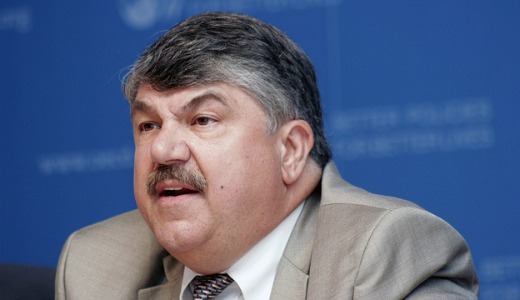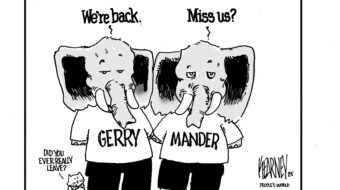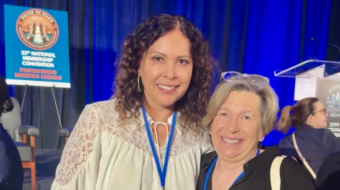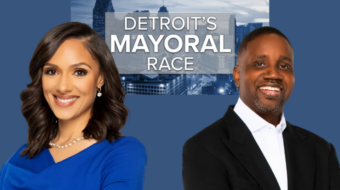
SILVER SPRING, Md. – The AFL-CIO will create a “SuperPAC,” a separate campaign finance committee that can communicate with the general public – and raise money without any contribution limits – as part of an overall revamp of its political operation, Michael Podhorzer, the federation’s new political director, says.
In an interview with reporters covering the AFL-CIO Executive Council meeting in Silver Spring, Md., Podhorzer said that although details of the SuperPAC remain to be flushed out, the aim is clear: the labor movement is seeking to expand its influence in the political arena beyond its own membership.
“It’s the legal vehicle to talk to the general public in campaigns,” using paid media and other communication methods, he said.
SuperPACs sprang up – almost all on the right – after the U.S. Supreme Court’s 2010 Citizens United decision, allowing corporations, individuals and unions virtually unlimited giving to campaign organizations, but not candidates. Regular campaign finance committees, or PACs, have contribution limits.
And regular PACs also must disclose their donors. SuperPACs do not have to do so. The monster SuperPAC of the 2010 cycle, American Crossroads, run by George W. Bush’s political guru, Karl Rove, did not disclose the names of its corporate backers.
The right-wing SuperPACs’ money helped the GOP-business-radical right combo swamp labor-backed candidates in the 2010 election, giving that cabal control of the U.S. House and many governorships and legislatures. They’ve used that control to attack workers, unions and the middle class in the states and on Capitol Hill.
The SuperPAC was just one feature the council approved for the federation’s political program revamp in the run-up to the 2012 elections. AFL-CIO President Richard Trumka has forecast a revamp for months. Other political decisions included:
* Declaring “a greater independence and investment in labor political activity itself,” apart from the Democratic Party. Podhorzer said labor had made such pledges in the past, but never put money behind them. The council promised to do so now, but has yet to set figures or percentages – or seek a new dedicated money source.
“Given the dire economic times, our money would be better invested in building worker political power…and only supporting those candidates who support workers,” he explained.
That means so-called “Blue Dog” Democrats will not get backing, and that labor will actively hunt out pro-worker hopefuls for open seats.
* Continuing to turn labor’s political operation into a year-round structure, focused on issues – especially jobs – and not just on officeholders. The difference, he said, is that the apparatus would link those top issues to specific candidate stands on them.
* Beyond Wisconsin, where unions have mobilized tens of thousands of people for six key state senate recall races, labor will concentrate its next efforts in Ohio. That will be followed by “hard choices about people and resources” in other states the federation’s Executive Committee – the 21-member body of top union leaders that meets more frequently to decide key issues – will select.
* In Wisconsin, right-wing GOP Gov. Scott Walker’s abolition of collective bargaining for 200,000 state and local workers brought up to 100,000 people to protests at the state capitol.
It also began labor’s first big political test of its fight back against the right-wing-business-GOP cabal to smash unions, destroy pay and pensions and wreck the middle class: recall elections Aug. 9 against six of Walker’s 19-member GOP state senate majority. If Democrats, backed by unions, win three of the six, Walker’s majority ends.
* In Ohio, the second biggest battleground, right-wing GOP Gov. John Kasich pushed an even more draconian law, SB5, through his GOP-run legislature. It not only strips 350,000 workers of collective bargaining, but also outlaws strikes, puts workers’ raises up for local referendums and enacts other anti-worker restrictions.
Labor gathered 1.3 million signatures to force repeal of SB5 onto the November ballot in a referendum. “You will see a huge effort, beginning this month, in Ohio, and in other states, beginning in September, to get people out,” Podhorzer said. “There’ll be even greater staffing and mobilization” than before.
* “Endorsements in political races,” except for the U.S. presidency “will still be by state federations, but the Executive Committee will try to get everybody together on a relatively small set of priority” endorsements in U.S. House, Senate and state legislature races. There will also be “a higher standard” for endorsements, Podhorzer promised.
* Labor will shoot for a minimum of 11 contacts with each union member in each race it is interested in, a standard Podhorzer first announced at the Utility Workers political conference before the 2010 election. “But there will be different numbers of contacts for different races,” he said. “We’ll also be looking very carefully at how contacts through social media affect a race – and which members are the most important to contact.”
Photo: AFL-CIO President Richard Trumka OECD // CC 2.0










